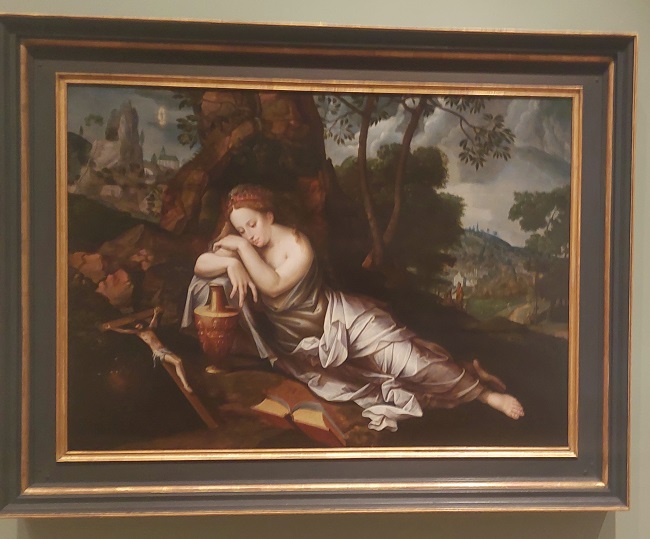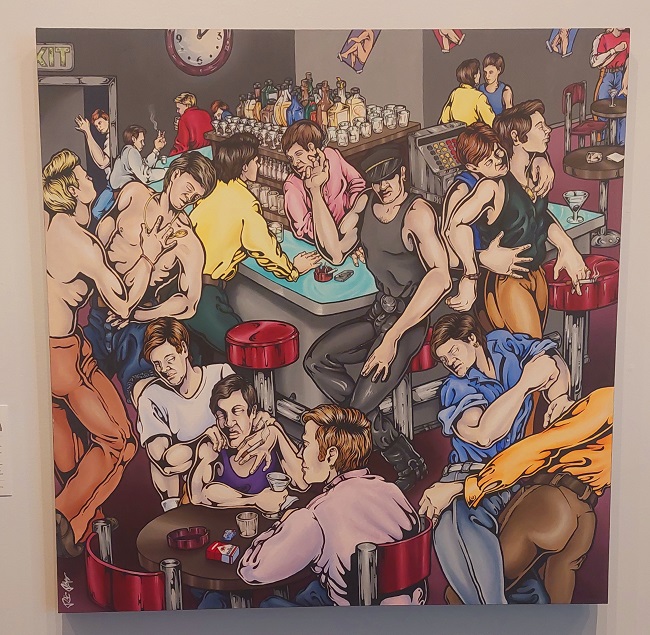Museum Impressions:
Revisiting the Birmingham Museum of Art
I've been to the Birmingham (Alabama) Museum a few times now, and wrote a more comprehensive look at it previously. This time, I decided to simply let my eyes guide me to pieces that were particularly compelling.
 |
| The Penitent Mary Magdalene, about 1535-40 | Oil on canvas |
The museum is a perfect for wiling away afternoons, with a delightful warren of rooms stuffed with art and artifacts that stem from spacious hallways.
Cool Things About The Birmingham Museum Of Art
- Meditate with Art, a space where you can sit down, take some time, and contemplate great works of art.
- A Sensory Empowerment Program designed for visitors with low to no vision or sensory needs, where they can experience art through touch.
This comes in no particular order.
I do love their collection of Wedgewood and other fine porcelain and pottery.
 |
| Teapot, about 1820-1830 | Stoneware (Rosso Antico) |
 |
| Covered Urn, 1780-1800 | White stoneware |
 |
| Unfit Frame, 2016 by Titus Kaphar | Oil on canvas with gilded antique frame, books, broom and platform |
From an artist's statement:
Look around you. The story of English art in the 1700s as told by the works in this gallery is lopsided. It masks an important aspect of british history by not referencing tits colonies and its deep involvement in the human trafficking of enslaved people. In many instances, this created the wealth that allowed the people portrayed here to commission these works in the first place. Many contemporary artists aim to expose these often untold histories.
Titus Kaphar's Unfit Frame calls attention to Elihu Yale (1649-1721), a British slave trader, merchant, and President of the English East India Company in Madras, India.
Yale is the namesake for Yale University, which was founded, in part, with money Yale made from trading enslaved men and women. Unfit Frame is inspired by portraits of Yale, who was often depicted with enslaved African people in the background. Kaphar crumples and reworks the composition into the frame, asking the visitor to critically examine what is "swept under the rug" in these portraits (note the broom) and highlighting the stories of those erased by white artists and culture.
From the courtyard:
.jpg) |
| The Fall, 1971, by Barry Woods Johnston (American, Alabama, born 1941) |
 |
| School of Beauty, School of Culture, 2012 by Kerry James Marshall (American, born 1955) | Acrylic and glitter on unstretched canvas |
 |
| Julius Casesar Offering Food & Wine to the Roman People, 1589-1590 from the workshop of Antonio Patanazzi | Tin-glazed earthenware |
 |
| Julius Casesar Offering Food & Wine to the Roman People, 1589-1590 from the workshop of Antonio Patanazzi | Tin-glazed earthenware |
.jpg) |
| Detail from Last Judgment, abt 1596 by Leandro dal Ponte, called Leandro Bassano (Italian, 1557-1622) | Oil on copper |
 |
| Hercules Freeing Prometheus, 1703 by Nicolas Bertin (French, 1668-1736) | Oil on canvas |
 |
| L'Envouteuse (The Sorceress), 1883 by Georges Merle (French, 1851-1886) | Oil on panel |
.jpg) |
| Detail from L'Envouteuse (The Sorceress), 1883 by Georges Merle (French, 1851-1886) | Oil on panel |
From an artist's statement:
Gizmo Lounge was a popular gay bar and disco on the Southside of Birmingham from the 1960s to 1980s. To memorialize this closed by long beloved space, Patrick Cather commissioned artist Robin Richeson Colter to capture Gizmo from his memories. Gizmo Lounge is shown at capaicty with men talking, dancing, drinking, smoking and carousing.
 |
| Gizmo, 1993 by Robin Richeson Colter (American, born 1965) |
.jpg) |
| Grand Canyon, Yellowstone River, Wyoming, 1886 by William Louis Sonntag, Sr. (American, 1822-1900) | Oil on canvas |
.jpg) |
| Detail from Grand Canyon, Yellowstone River, Wyoming, 1886 by William Louis Sonntag, Sr. (American, 1822-1900) | Oil on canvas |
 |
| The Potter, 1982 by Allan Houser, Chiricahua Apache people (Born Apache, OK 1914, died Santa Fe, NM 1994) | Bronze |
From the Art as Intervention/Activism collection:
 |
United States Steel Corp., McDonald Works, Youngstown, Ohio, 1986 by Raymon Elozua (born West Germany 1847, based in Mountaindale, New York) | Mixed media, steel, rock, slag and detritus on wood - detail.jpg) | | United States Steel Corp., McDonald Works, Youngstown, Ohio, 1986 by Raymon Elozua (born West Germany 1847, based in Mountaindale, New York) | Mixed media, steel, rock, slag and detritus on wood |
From the artist's statement:In September 1977, a majority of steelworkers in Youngstown, Ohio lost their jobs as a result of overwhelming industrial decline. Raymon Elozua captures Youngstown almost ten years later as the steel factory sits empty, surrounded by broken pipes and disintegrating rubble, a haunting record of the effects of the steel industry on the American landscape.
 | | Burning Earth, 1983 by Cham Hendon (American, 1936-2014) | Acylic, Rhoplex, and newsprint on canvas |
.jpg) | | Horse, about 720, Chinese, Tang dynasty (AD 618-907) |
 | | Horse, about 720, Chinese, Tang dynasty (AD 618-907) |
 | | Seated Two-Armed Ganesha, God of Success, 10th century Koh Ker style (921-944), Khmer period (802-1431) by an unidentified artist in Burira province, Thailand | Sandstone |
Always worth checking out.
|




.jpg)



.jpg)


.jpg)

.jpg)
.jpg)


.jpg)

.jpg)


Comments
Post a Comment